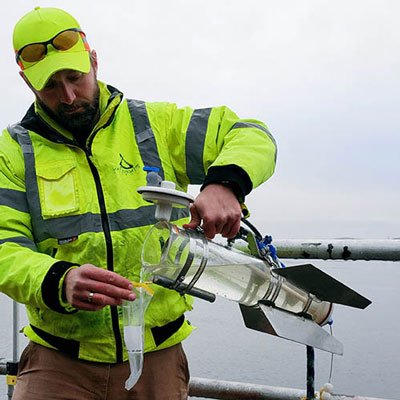 Tyler Winter, environmental scientist for Metropolitan Council Environmental Services, is an advocate for native nongame fish. He’s gone online to proclaim their value.
Tyler Winter, environmental scientist for Metropolitan Council Environmental Services, is an advocate for native nongame fish. He’s gone online to proclaim their value.
“I’m trying to educate people that these native nongame fish exist, and they support other fish and wildlife that people know about and like,” Winter said. “I also try to stress that there are no limits protecting them and they are vulnerable to overharvest.”
In his day job, Winter monitors water quality in area rivers. When off-duty, he fishes these same waters and educates people about certain fish that have been much maligned through history.
Tied closely to Winter’s water quality vocation is his avocation – fishing for and sharing information on what have been designated native nongame fish. There are 26 species of these fish in Minnesota, with the bigmouth buffalo and the river redhorse among the notable. Some people call them “rough fish,” but Winter feels that prompts a negative reaction that he is trying to change.
So-called “rough fish” provide many benefits
“These are good fish,” Winter said. “They are native and are important parts of the ecosystem that support other things, such as eagles. Most people don’t know these fish even exist. Those who do often malign them and have spread more myths than truths.”
According to Winter, native nongame fish are indicators of good water quality and good habitat. And they help combat invasive species. Bowfin and gar are known to eat non-native carp. Freshwater drum, bigmouth buffalo, and river redhorse prey on zebra mussels. Nongame fish support food webs in subtle ways, too. Studies have shown migrating suckers increase the productivity of streams. Some rare species, like the black buffalo, are even listed as threatened or of special concern.
Bigmouth buffalo considered a delicacy in Asian American cultures
“But why don’t we know much about these fish?” Winter asks. “It’s mostly because Caucasian people don’t typically eat them and thus don’t care much about them. Somebody in the 1950s decided that if they don’t eat it, then it should be labeled a rough fish.”
But you can eat them. The bigmouth buffalo, which can live to be more than 100 years old and weigh up to 50 pounds, are fished commercially. Many of them go to live fish markets on the East Coast, where they are considered a delicacy in Asian American cultures.
Besides their flavor, Winter likes that they are challenging and fun to catch. He doesn’t usually angle for game fish because he feels catching them is too easy. “Fish that bite shiny metal obviously aren’t that smart,” he said. And he is able to fish close to home. “While many people are driving to a lake or trout stream, I’m already catching fish on the Mississippi.”
Discovering mysteries in Minnesota waters
Winter’s interest in native nongame fish began when he caught a mooneye at age 14. “I didn’t know what it was, and my uncles didn’t either,” he said. “That showed me there are mysteries in Minnesota waters, and I tried to learn all I could about them. I grew to like rivers as a place to find diverse and mysterious fish.”
Winter set up an Instagram account this summer to promote and advocate for native nongame fish (@buffalo_catcher) and is up to more than 600 followers. He has also been featured in an online video showing two fishing “experts” the nuances of catching a bigmouth buffalo.

Where vocation and avocation meet
“My water sampling and my fishing complement each other,” Winter said. “As a scientist I am always measuring the river; as an angler I am always observing the river. Both give me insight into the processes that influence water quality and the impacts they have on the river and its inhabitants.”
Winter has nothing but praise for Metropolitan Council Environmental Services and its predecessor organizations that have built such a high-performing wastewater collection and treatment utility.
“We have this great resource that we are protecting through wastewater treatment, and the rivers have rebounded immensely,” he said. “We have good water quality providing good habitat. That leads to diverse food webs, which support good fishing for people and wildlife. I’m proud to be part of all this.”